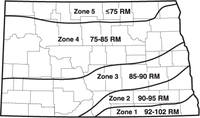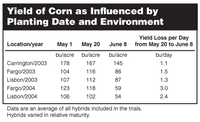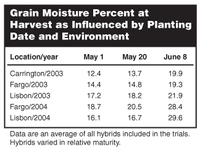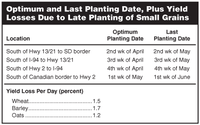NDSU Offers Guidelines for Late Planting of Small Grains and Corn
(Click an image below to view a high-resolution image that can be downloaded)
-

Corn Maturity Zones of North Dakota -

Recommended relative maturity corn hybrids for various regions and planting dates -

Yield of corn as influenced by planting date and environment -

Grain moisture percent at harvest as influenced by planting date and environment -

Optimum and last planting date, plus yield losses due to late planting of small grains
Small grains are cool-season crops that require relatively cool temperatures to achieve high yield potential. Therefore, when planted late, small grains develop during warmer temperatures that are detrimental to yield.
“When planting is delayed beyond the last optimal planting date, yield reductions accelerate and profitable crop production becomes risky,” says Joel Ransom, North Dakota State University Extension Service agronomist. “Full insurance coverage is available until June 5 in northern-tier counties and until May 31 in all other counties. Of the small grains, oats is the most tolerant to late planting and barley the least tolerant.”
When planting is delayed beyond the optimum date, it may be beneficial to increase the seeding rate by 1 percent per day of delay up to a maximum of about 1.6 million seeds. This increase will compensate partially for the decrease in grain yields associated with reduced tillering that occurs when plants develop in warmer rather than optimum temperatures.
Though differences in the maturity of commonly grown small-grain varieties are not great, earlier-maturing varieties are recommended for planting dates near June 1. For spring wheat, varieties from South Dakota (Briggs, Granger and Traverse), along with Glenn, Kelby, Oklee and RB07, are among the earliest maturing. Data from South Dakota and southern locations in Minnesota also suggest that Steele-ND and Howard tolerate heat better than many of the other varieties released by NDSU and will perform relatively well when planted late.
Corn is a warm-season crop and requires warmer temperatures than small grains before it will germinate and grow.
“The main concern with late-planted corn is that it will be at risk of being killed by frost before it reaches physiological maturity, so yield and grain quality will be reduced,” Ransom says. “Delayed planting also increases the probability that the harvested grain will be wet, difficult to handle and expensive to dry.”
The recommended planting date for corn in all regions of the state is May 1, with little negative impact most years and locations if planting is delayed until May 20. However, the recommended maturity of the hybrid to be grown varies significantly by location. Selecting earlier-maturing hybrids when planting is delayed beyond May 20 (except for the northern tier) is recommended.
The final planting date for full insurance coverage for corn is May 25, except for Cass, Ransom, Richland and Sargent counties. These counties have a final planting date of May 31.
Research in southeastern North Dakota indicates that yield losses and grain moisture increases at harvest are minimal if the corn is planted by May 20. Plantings delayed into the first week of June, however, resulted in yield losses between 1.1 and 3 bushels per day. Yield losses were the largest in 2004.
NDSU Agriculture Communication
| Source: | Joel Ransom (701) 231-7405, joel.ransom@ndsu.nodak.edu |
|---|---|
| Editor: | Rich Mattern, (701) 231-6136, richard.mattern@ndsu.nodak.edu |
Attachments
- PDF - Corn Maturity Zones of North Dakota - (20.83984375 kb)
- EPS - Corn Maturity Zones of North Dakota - (151.8349609375 kb)
- PDF - Recommended relative maturity corn hybrids for various regions and planting dates - (17.5146484375 kb)
- EPS - Recommended relative maturity corn hybrids for various regions and planting dates - (218.8828125 kb)
- PDF - Yield of corn as influenced by planting date and environment - (18.705078125 kb)
- EPS - Yield of corn as influenced by planting date and environment - (224.0107421875 kb)
- PDF - Grain moisture percent at harvest as influenced by planting date and environment - (18.1376953125 kb)
- EPS - Grain moisture percent at harvest as influenced by planting date and environment - (219.1259765625 kb)
- PDF - Optimum and last planting date, plus yield losses due to late planting of small grains - (18.404296875 kb)
- EPS - Optimum and last planting date, plus yield losses due to late planting of small grains - (225.65625 kb)

